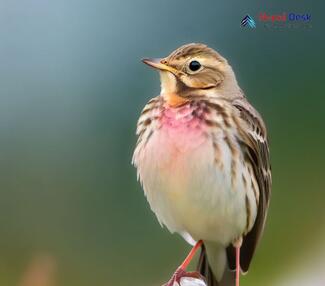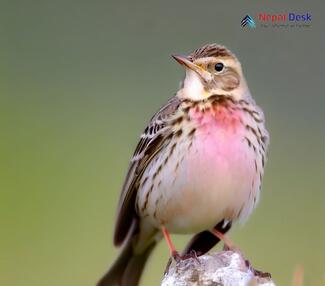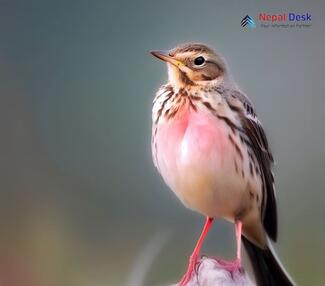The Rosy Pipit (Anthus roseatus) is a captivating bird species, known for its striking appearance and intriguing behavior. In this article, we will delve into the taxonomy, physical features, habitat, diet, presence in Nepal, and other fascinating aspects of this remarkable avian species.
Taxonomy and Physical Features
The Rosy Pipit is classified within the family Motacillidae and belongs to the genus Anthus. This beautiful bird is characterized by its size (approximately 16-18 cm) and its distinct pink-tinged plumage. In addition to the rosy hue that gives it its name, the bird possesses brown upperparts with streaks of black and white underparts. Its pinkish breast and flanks also have darker streaks, creating an appealing contrast.
Habitat and Distribution
Rosy Pipits are primarily found in wet meadows and grasslands, particularly at high elevations. Their preferred habitats also include alpine shrublands, steppes, and mountain plateaus. They can be found in various parts of Asia such as Mongolia, China, Bhutan, Northeast India, and Nepal. During winter months, these birds migrate to lower elevations in Southeast Asia.
Presence in Nepal
In Nepal, the Rosy Pipit can be encountered in protected areas like Sagarmatha National Park and Makalu Barun National Park. Nesting typically occurs between May and August at elevations between 3,000 meters to 4,500 meters above sea level. As such, keen birdwatchers visiting Nepal during those months may have the opportunity to catch sight of this beautiful species.
Diet
The diet of the Rosy Pipit primarily consists of insects and other small invertebrates like worms and spiders. Additionally, they consume seeds from a variety of plants commonly found in their habitat. This varied diet helps the Rosy Pipit to thrive in diverse environments.
Interesting Point: Nest Building and Breeding Behavior
One of the most fascinating aspects of the Rosy Pipit's life is its elaborate nest-building process. The nests are cup-shaped and made from fine grasses, leaves, and other plant materials. They are often well hidden among the dense grasses and close to the ground to avoid detection by predators. As a monogamous species, both the male and female take part in nest building, incubation, and feeding of the young after hatching.
In conclusion, the Rosy Pipit is a captivating bird species that can be found in the high-elevation habitats of Nepal. Its stunning appearance, intriguing behavior, and diverse diet make it a fascinating subject for birdwatchers and nature enthusiasts alike. By raising awareness of this unique bird, we hope to contribute towards its conservation and appreciation in the years to come.




